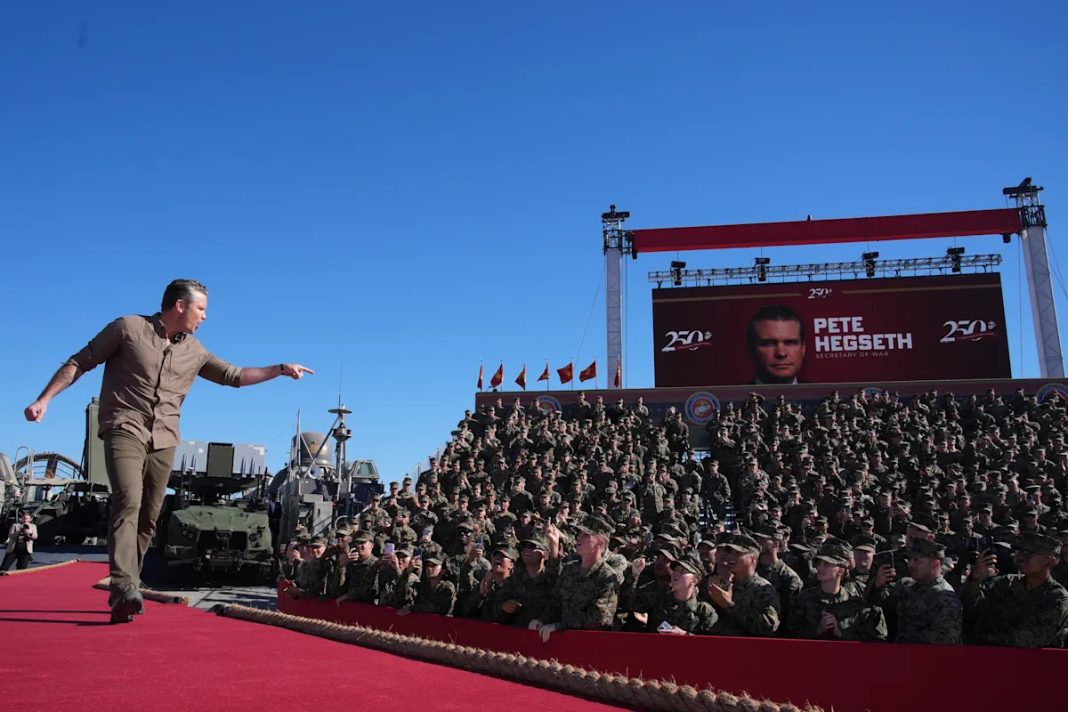Since taking the reins of the Pentagon, Defense Secretary Pete Hegseth has fired his top military adviser, nearly his entire roster of civilian aides and all of his senior legal officers. But he has not done so to install his preferred candidate, until now.
Hegseth’s latest move — to place his senior military aide in a top Army post — represents one of his most assertive steps yet in determining who shapes the future of the Pentagon. President Donald Trump this week nominated Lt. Gen. Christopher LaNeve to replace Army Vice Chief of Staff Gen. James Mingus, even before the four-star general’s departure was announced, turning a service that has remained largely immune from leadership purges into the epicenter of them.
The effort differs from Hegseth’s other high-profile dismissals in that he has chosen the replacement, aiming to substitute a widely respected leader not even two years into his job with a lesser experienced candidate who would need a promotion to take on the role.
“Hegseth wants his guy in,” a defense official said. “Who he replaces doesn’t matter.”
The Senate still needs to approve LaNeve, a former 82nd Airborne Division commander, who since April has served as the liaison between the secretary and other branches of government. But the potential replacement ricocheted through the Pentagon, according to three defense officials, as top brass continue to digest Hegseth’s all-hands admonition to hundreds of generals and admirals last month that they “should do the honorable thing and resign” if they don’t agree with his vision for the department.
The decision hit especially hard in the Army, which is led by Dan Driscoll, a close friend of Vice President JD Vance’s and a widely-liked leader some in the Pentagon have floated as a potential replacement for Hegseth. The move could further strain their relationship.
“Pete is always looking for the first signs of trouble and his inner circle is small and paranoid,” said one of the officials, who like others interviewed, was granted anonymity to discuss highly sensitive topics. “But I haven’t seen anyone lobbying for his job overtly or covertly.”
The Defense Department directed questions to the Army.
Army spokesperson Maj. Peter Sulzona said the office would not comment on pending nominations. “General Mingus will continue to execute the duties and responsibilities of his position, focusing on warfighting and the well-being of our soldiers,” he said.
LeNeve could not be reached for comment and the Defense Department declined to make him available.
Driscoll has publicly said his relationship with Hegseth is productive. But the Pentagon chief did not come to Driscoll’s defense in August when conservative conspiracy theorist Laura Loomer, who has made a project of getting Trump officials fired for questioning their MAGA loyalty, called for his ouster. The department, days later, offered a softer rebuttal.
LaNeve’s nomination wasn’t announced by Hegseth, but appeared in the congressional record. Mingus also didn’t announce his departure, even though he was less than halfway into what is normally a four-year role.
Many in the Pentagon questioned the ouster, according to the officials, a decorated officer who is playing a leading role in Driscoll’s signature modernization efforts.
LaNeve first interacted with the Trump administration during the president’s inauguration. LaNeve, then the commanding general of the Eighth Army in South Korea, was beamed into the Commander in Chief’s Ball on January 20 to give remarks.
“It’s a profound honor to stand before you today representing our incredible team here in Korea,” he added. “Congratulations on your victory as the 47th President of the United States.”
Hegseth, weeks later, pulled him out of South Korea and brought him to the Pentagon to work side-by-side.
The senior military assistant role is often a stepping stone for officers, who move on to four-star commandments members of the Joint Chiefs. Army Chief of Staff Gen. Randy George served as the senior military aide to former Defense Secretary Lloyd Austin before he was promoted to vice chief of staff.
Mingus has served as the Army’s No. 2 officer since January 2024. He was previously director of the Joint Staff, and has led the Army’s signature “transformation in contact” initiative. The effort involves using new technologies with troops in the field to rapidly discover what works. He also led troops in combat in Iraq and Afghanistan, was commander of the 82nd Airborne Division and has served in Army Special Forces assignments.
Mingus had been in the running to lead U.S. Central Command this year, but the Trump administration instead chose Vice Adm. Brad Cooper for the post.
The move follows a litany of recent leadership shifts in other services. Hegseth last week announced that the head of U.S. Southern Command, Adm. Alvin Holsey, would retire by the end of the year. The commander, who is overseeing controversial strikes against suspected drug trafficking vessels in the Caribbean Sea, is leaving less than a year into his tenure.
Air Force Chief of Staff Gen. David Allvin is set to retire next month, just halfway into a four-year term. His replacement, Gen. Kenneth Wilsbach, is waiting on Senate confirmation. There is no nominee for the vice chief of the Air Force after the departure of Gen. James Slife in February.
Hegseth has grown increasingly suspicious during his short tenure. He fired many of his closest advisersearlier this year, and has surrounded himself with a small circle of confidants, including his wife and a handful of officials. He’s also restricted Pentagon press corps’ access to the department and banned most staff from participating in think tank events.

